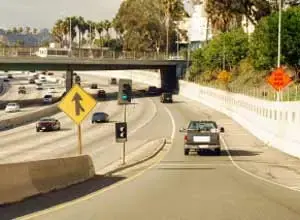Driving on the road and entering a freeway is an essential part of modern driving, which requires a combination of skill, awareness and adherence to traffic rules.
Driving from the on-ramp to the highway safely gives the driver the tone and experience of a fast, multi-lane highway.
In this report, we delve into the most important aspects and best practices of driving on the road and emphasize the importance of seamlessly merging into high-speed traffic while putting safety first.
1. Preparation to enter the country:
Drivers must prepare themselves before entering the road. This includes checking the vehicle and its condition, making sure all lights and turn signals are working and making sure the mirrors are properly adjusted. Additionally, drivers should be aware of their vehicle and its acceleration characteristics, as merging onto the freeway often requires quick and confident acceleration to match the speed of oncoming traffic. A well-maintained vehicle and driver readiness are essential foundations for safe access to the road.
2. Monitoring the Traffic Flow:
Monitoring the traffic flow on the highway is a critical step before joining the highway. Drivers should assess the speed and distance of vehicles traveling in the right lane on the highway and adjust their approach accordingly. Understanding vehicle spacing allows for smoother entry, minimizing the need for sudden movements. Ideally, drivers should try to blend in an opening that allows for seamless integration without disrupting traffic flow.
3. Use of traffic lights:
Most freeway ramps are equipped with traffic lights or turn signals to control vehicles entering the freeway. Drivers should pay attention to these signals as they guide the merging process and help maintain a smooth flow of traffic. Responsible use of crawl signals and following posted directions will contribute to a more organized and efficient connection experience.
4. Achieving Matching Speeds:
One of the biggest challenges when entering the highway is reaching matching speeds with vehicles already on the highway. Drivers driving on ramps must accelerate to the extent necessary to reach the speed corresponding to the flow of traffic. Attempting to merge at significantly lower speeds or hesitating can disrupt the rhythm of freeway traffic, leading to potential safety hazards. The goal is to seamlessly blend into the traffic stream without causing unnecessary disruptions.
5. Utilizing Acceleration Lanes:
Acceleration lanes, often present on freeway on-ramps, provide additional space for drivers to reach highway speeds before merging. These lanes are designed to allow for a smoother transition into traffic, reducing the need for sudden acceleration or abrupt maneuvers. The use of full-length acceleration lanes gives drivers the space and time needed to match speeds and smoothly merge into freeway traffic.
6. Blind Spot Check:
Drivers must thoroughly check their blind spots before connecting. Blind spots are areas around the vehicle that are not visible from the rearview mirrors or side mirrors. Freeway traffic can be fast and a quick glance over your shoulder ensures no vehicles in adjacent lanes are blocking your view. Blind spot monitoring is a basic practice that improves overall safety when entering the highway.
7. Safety Lane Change:
Merging on a freeway often requires a lane change to find an adequate gap in traffic. Drivers should change lanes safely by using their turn signals according to their intentions and making sure there is enough space in the lane to move. Frequent and irregular lane changes can cause confusion and endanger both the merging driver and other vehicles on the road. Safe and appropriate lane changes promote harmonious traffic.
8. Adaptation to road speed:
Successful merging into the highway requires adaptation to the higher speeds characteristic of road driving. Drivers entering the highway must immediately adapt their speed to the flow of traffic. It is important to avoid impeding the forward movement of other vehicles and merging drivers should try to merge smoothly with the speed of the road.
9. Maintain a safe following distance:
After joining the road, maintaining a safe following distance is most important. Backsliding can lead to dangerous situations, especially at higher speeds. Adhering to the recommended following distances allows drivers to respond effectively to changing traffic conditions, sudden stops or unexpected movements of other vehicles.
10. Freeway Intersection Handling:
In some cases, entering a freeway requires navigating complex intersections where multiple lanes merge or diverge. Adequate signage, attention to lane markings and a clear understanding of the planned route are crucial to safely negotiating motorway junctions. Following the instructions and choosing the appropriate routes in advance will help avoid last-minute moves and reduce the risk of confusion.

Conclusion:
Road driving is a dynamic and critical part of driving that requires a combination of preparedness, observation and skill. Successfully connecting vehicles on the road creates the foundation for a safe and efficient travel experience. By following good practices such as using on-ramp signs, maintaining the appropriate speed and maintaining a safe following distance, drivers can contribute to the overall safety and smoothness of traffic. Negotiating the on-ramp becomes a seamless process when drivers prioritize safety, adapt to highway speeds, and remain vigilant throughout their journey on the freeway.
